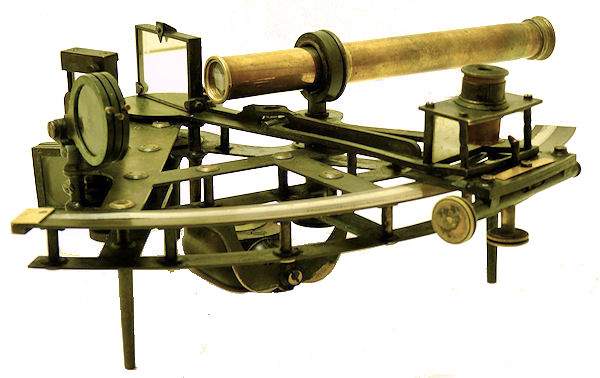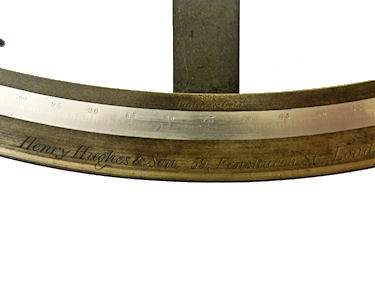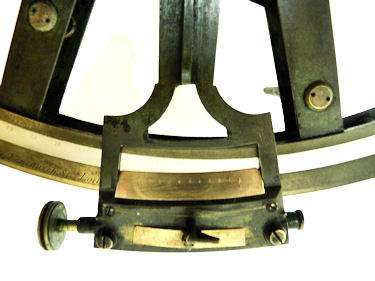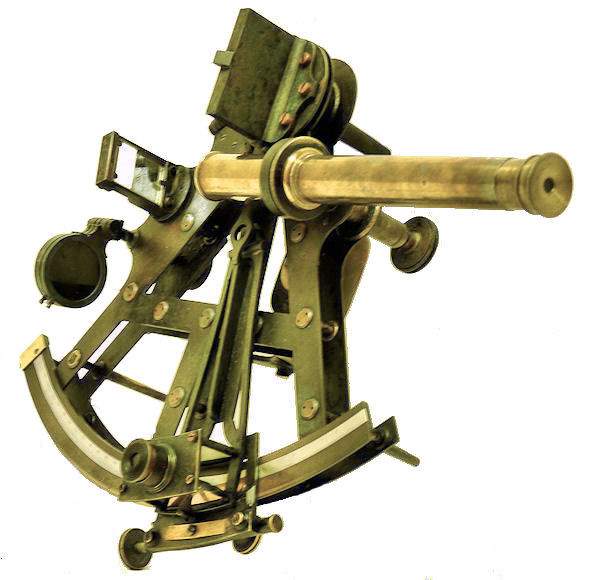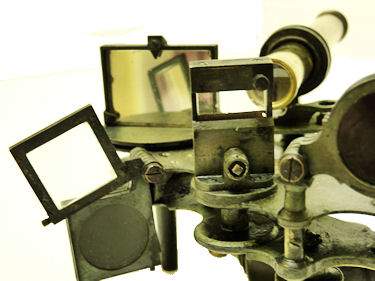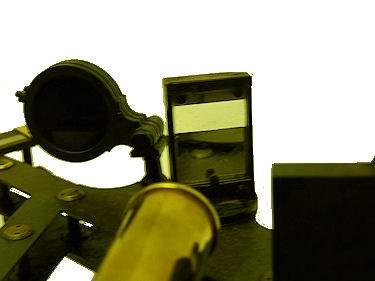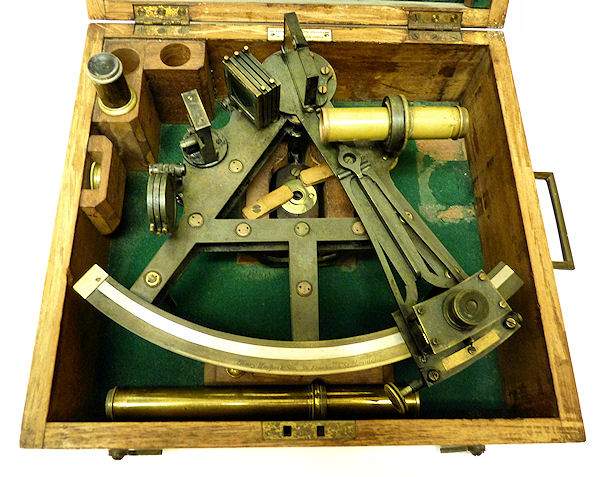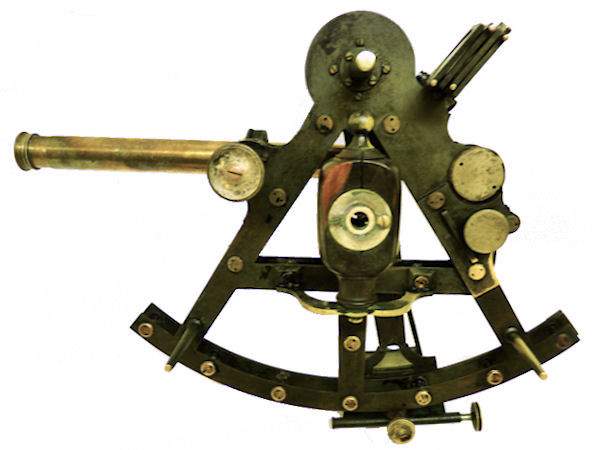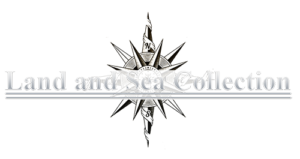H. HUGHES & SON
DOUBLE FRAME QUINTANT/SEXTANT
Ca
1890
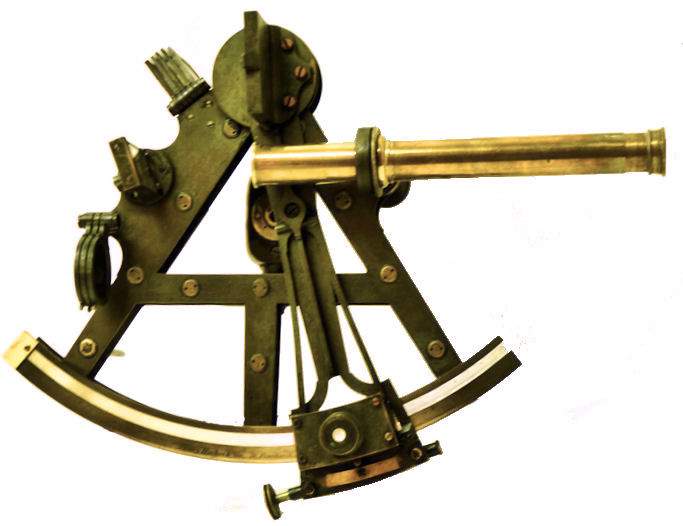
Reserved
PRESENTED is a fine late 19th
C. mariner’s double frame quintant with graduated “Platina“ (platinum) arc and gold vernier, and
brass frame and fittings. Engraved at mid-center of the arc at the bottom is “Henry Hughes & Son, 59 Fenchurch
St. London”, one of England’s foremost “Class A“ instrument makers. Over this is the serial number 3802. The instrument
is mainly shown with the high power collimation telescope fitted.The original inspection certificate issued
by the Kew Observatory, Richmond, Surrey, in October, 1890 is mounted in the case. Like modern instruments, no error is greater
than 20 arc seconds over its usable range.
double or pillar frame sextant was invented by Edward Thoughton, one of England’s premier instrument makers, in 1788.
It is comprised of two relatively light weight sheets of brass making up the frame that are held together by a series
of pillars, nineteen in total. This formed a rigid frame on which mounted the mirrors, shades, a telescope, index
arm, and magnifier. The Troughton double frame sextant added to the inventors reputation, but it was a highly complex instrument
to make, and gave way to more simplified designs in the mid 19 th Century. The Henry Hughes quintant is an exact
copy of the Throughton instrument, and may in fact have been made for Hughes by Throughton.
The Hughes family were originally clockmakers in the East End of London who progressed into supplying sextants and chronometers
to ships coming into the River Thames. In 1712 Thomas Hughes became a member
of the Worshipful Company of Clockmakers at the age of 26, and was elected as Master of the Worshipful Company of Clockmakers
in 1742. His son, Thomas Hughes (junior), had his business at 25 New Bond Street, London, and was elected as Master of the
Worshipful Company of Clockmakers in 1762. In 1781 William Hughes, believed
to be the son of Thomas Hughes Junior, was elected freeman of the Worshipful Company of Clockmakers and sold a cabin clock
to captain Cook. Joseph Hughes, believed to be the son of William born in 1781, lived and worked at 16 Queen Street, Ratcliffe.
He was to become a well-known maker of quadrants and compasses. His son Henry Hughes was born in 1816.Henry Hughes & Son was founded in 1838 at 120, later 59, Fenchurch
St. in London, as an optician and maker of chronographic and scientific instruments. Henry
died in 1879 and his son Alexander succeeded him as chairman. The firm was incorporated as Henry Hughes &
Sons Ltd in 1903 and in 1923, the company produced its first recording echo sounder. In 1935, a controlling interest in the
company was acquired by S. Smith & Son Ltd resulting in the development of marine and aircraft instruments. Following
the London office’s destruction in the Blitz of 1941, a collaboration was entered into with Kelvin, Bottomley & Baird
Ltd, resulting in the establishment of Marine Instruments Ltd. Following the formal amalgamation of Kelvin, Bottomley &
Baird Ltd and Henry Hughes & Sons Ltd in 1947 to form Kelvin & Hughes Ltd, Marine Instruments Ltd acted as regional
agents in the UK for Kelvin & Hughes Ltd who were essentially now a part of Smith’s Industries Ltd founded in 1944 as
the successors of S. Smith & Son Ltd. The well known
“HUSUN” trademark was in use starting in the 1920s.
INSTRUMENT CONDITION: The mirrors are in remarkably near
new condition and show little age. The beautifully Rosewood handle has a minor age crack on the back. The index arm clamp,
and swing arm magnifier are complete and in good working order. The double frame has a beautiful dark patina that ranges from
shades of green to mid-night black. The instrument is in exceptional condition.
It comes complete with:
-
-
-
One sighting tube
-
One low powered scope
-
One high powered inverting collimation telescope
-
Special astigmitizer lens for twilight sights
-
Mirror adjustment pick
-
One adjustment wrench
-
One ocular lens cap
-
Missing is one vial of oil
-
-
The non tarnishing platinum scale is calibrated -5 to +155 degrees
with a gold tarnish free vernier scale reading from the right from 0 to 10 arc seconds in 2 second intervals. The
sextant has four rectangular shades for the index mirror, one of which is a special astigmitizer, and three round shades for
the horizon mirror, all in good order. The telescope’s distance from the frame may be adjusted by turning a knob at the back
of the rising piece. This most useable feature was discontinued in later sextants because of its high cost. The instrument
and it’s accessories are housed in a square Mahogany carrying case which has brass hinges and latches and a lock, but no key.
|
|
|
|
LABELS AND TAG: On the cover of the case is a Union Railway THE CASE: The hardwood 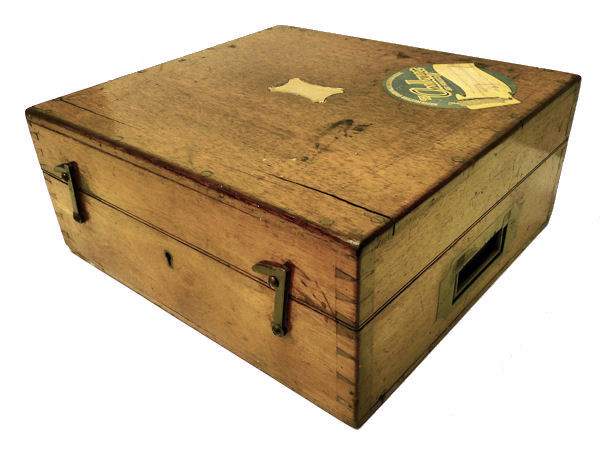 A very rare and highly DIMENSIONS: Length of index arm 9 1/4“ |
